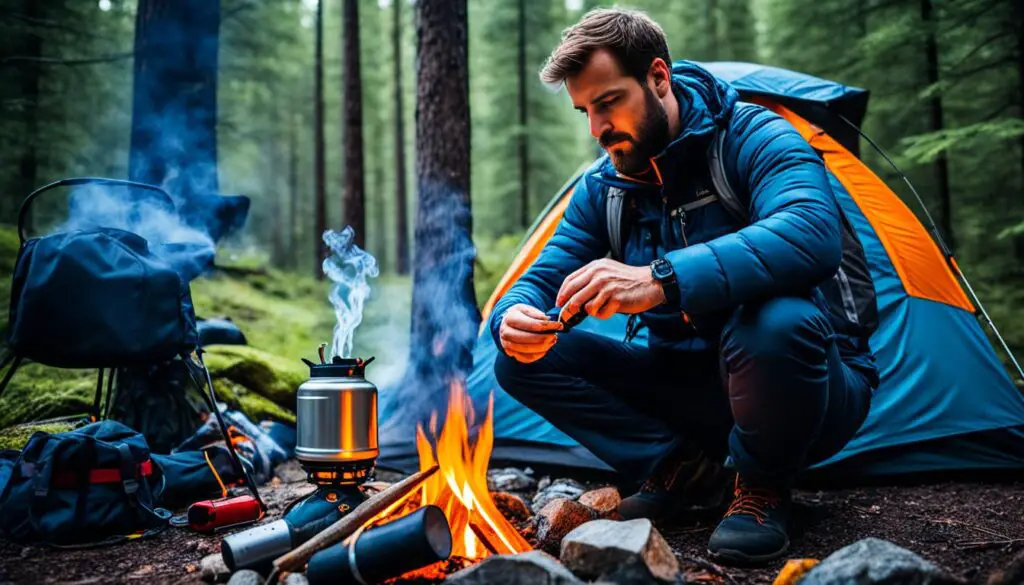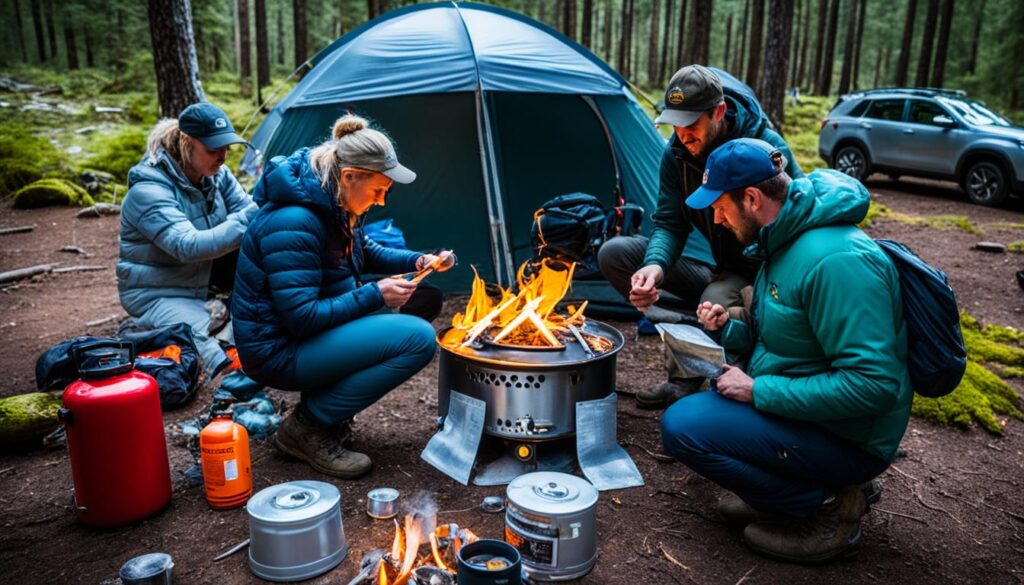Are Camping Stoves Safe
This guide explores the safety of camping stoves. I’ll give tips for a worry-free outdoor cooking experience. It’s key for both new campers and seasoned adventurers to know how to safely use and care for their stoves.
In times of high fire risk, there are about three times more fires than usual. This shows how crucial camping stove safety is. We’ll talk about the dangers of liquid fuels and invisible fires. I’ll also clear up common worries and myths about outdoor cooking. My goal is to help you understand and feel secure when using backpacking stove precautions and facing gas stove risks.
Introduction: Understanding the Risks of Camping Stoves
Camping stoves are key for cooking in the wild. Yet, they bring dangers campers need to know. We talk about why camping stove safety matters. And, we look at the challenges of using them outside.
Why Safety Matters in the Great Outdoors
Camping stove hazards are big risks like fires and carbon monoxide. These dangers can ruin a camping trip. That’s why taking care with outdoor cooking safety is so important. It keeps your camping memories good.
Common Concerns and Misconceptions
Some think they’re safe if they follow stove instructions. Others don’t see why good air and keeping the stove clean matter. But, these myths can be dangerous. It’s important to clear them up and make camping safer.
Knowing the dangers of camping stoves lets campers have fun safely. It helps everyone enjoy outdoor cooking and make great memories together.
Are Camping Stoves Safe?
Many people wonder if camping stoves are really safe. Those who love the outdoors share mixed views. Some believe their backpacking stoves are trustworthy. Others fear the dangers, especially around gas stove safety and propane stove risks. I will explore these nuances to help you choose your camping gear wisely.
The type of fuel a camping stove uses is a big concern. Propane and gas-powered stoves can leak or cause explosions. They may even lead to carbon monoxide poisoning. But, if you take care and follow the rules, these dangers can be lower. Always read the manual, check your gear often, and use your stove in a well-ventilated area.
The camping stove itself is also important. Choose stoves made by trusted brands. They often come with safety features like auto shut-off valves. These design elements lessen the risk of accidents. Picking stoves tested and approved by safety groups is a smart move.
But the biggest factor of all is how you use your camping stove. Setting it up right, checking it often, and watching over it are crucial. With care and knowledge, you can enjoy the outdoors safely. This keeps you and your family from harm.
Next, we will share essential safety tips for using camping stoves. These tips will help you make the best choices and stay safe in nature.
Essential Safety Tips for Using Camping Stoves
Camping stoves are key for outdoor fun, but they can be dangerous if not used safely. I, as a seasoned camper, gathered some must-know safety tips. These will help you use your camping stove without worries or problems.
Proper Setup and Operation
To start, read and follow the stove’s manual. You must set up the stove correctly, make sure the fuel is connected right, and check the connections. Also, always put your stove on a flat, solid place. Keep it far from things that can catch fire.
- Carefully read and follow the manufacturer’s instructions for your specific camping stove model.
- Ensure the fuel canister is properly connected and tightened to prevent leaks.
- Place the stove on a stable, level surface away from any flammable materials or structures.
- Keep a safe distance from the stove while in use, and never leave it unattended.
Ventilation and Carbon Monoxide Awareness
Camping stoves need good airflow to avoid making carbon monoxide (CO). Always use your stove outside in fresh air. Don’t use it in small, closed places like tents or RVs.
- Use your camping stove only in well-ventilated outdoor areas, never in enclosed spaces.
- Be aware of the symptoms of carbon monoxide poisoning, such as headache, dizziness, and nausea.
- Invest in a portable CO detector to ensure your safety while camping.
Stick to these tips for a safe and fun time with your camping stove. Being ready and careful is key for a great outdoor trip. Always think about your and others’ safety first.
Choosing the Right Camping Stove for Your Needs
Choosing a camping stove might seem hard, but it doesn’t have to be. There are many types of stoves out there. It’s important to know what you need. Then, you can pick the best one for your next adventure. Let’s look into what you need to think about when choosing a gas or propane stove.
The first thing to do is decide what fuel you want to use. Stoves can run on propane, butane, or white gas. Propane stoves work well and are easy to use. Butane stoves are light and small, great for backpacking. White gas stoves give a lot of heat but need more care.
Think about what features you want in a stove, too. This includes size, weight, how many burners, and how it controls heat. For cooking with a group, a stove with several burners is good. If you want something you can take backpacking, pick a light, single-burner stove.
| Fuel Type | Pros | Cons |
|---|---|---|
| Propane | Reliable performance, easy to use | Canister can be bulky, limited cold-weather performance |
| Butane | Lightweight and compact, good for solo use | Limited heat output, not as reliable in cold weather |
| White Gas | Powerful heat output, versatile | Requires more maintenance, can be difficult to find fuel |
It’s key to think about each feature when making your choice. Look at what’s good and not so good about each stove. Then, you can find the stove that’s just right for you. No matter if you love backpacking or just like to camp, the perfect stove will help make your time in nature fun and safe.

Maintenance and Storage: Keeping Your Camping Stove in Top Condition
It’s key to keep your camping stove clean and stored well. Doing so ensures it stays safe and works well for a long time. Clean it regularly and check for any potential problems. The right way to store it protects your stove from harm.
Cleaning and Inspecting Your Stove
After each use, always clean your stove well. Use a damp cloth to wipe outside. Then, a soft brush is perfect to clean the burners and grates. Check the fuel parts for damage too. This keeps your stove safe and working right.
Proper Storage Techniques
When it’s not being used, store your stove correctly. Disconnect the fuel and keep them in a ventilated spot. Store the stove in a cool, dry place but not in direct sunlight or very hot areas. A case or cover can protect it from dust and moisture. These steps keep your stove in great shape for your next trip.
FAQ
Are camping stoves safe to use?
Yes, if used the right way, camping stoves are safe outdoors. But, knowing the risks and taking safety steps is key for a safe time.
What are the common safety concerns with camping stoves?
There are dangers like fire, explosion, and carbon monoxide. Prevent them by setting up right, keeping good airflow, and checking your stove often.
How can I ensure my camping stove is set up safely?
Safe setup includes a steady surface, good air flow, and keeping it away from fire risks. Always follow the manual and check it regularly.
What should I do to prevent carbon monoxide poisoning while using a camping stove?
For safety from carbon monoxide, use your stove where there’s fresh air. Never cook inside. Know the signs of CO poisoning.
How do I properly store and maintain my camping stove?
Keep your stove clean and check for damage often. Store it cool and dry, and follow storage tips from the manual for safety and a long life.
What factors should I consider when choosing a safe camping stove?
Choose by looking at the fuel, safe features, and certifications. Pick stoves with secure bases, safety shut-offs, and good air flow for safer use outdoors.
